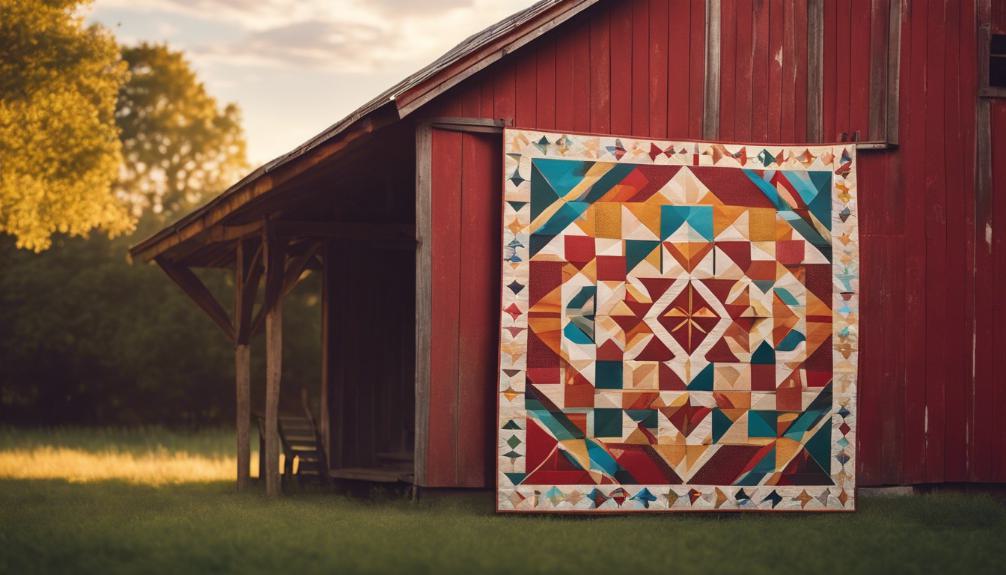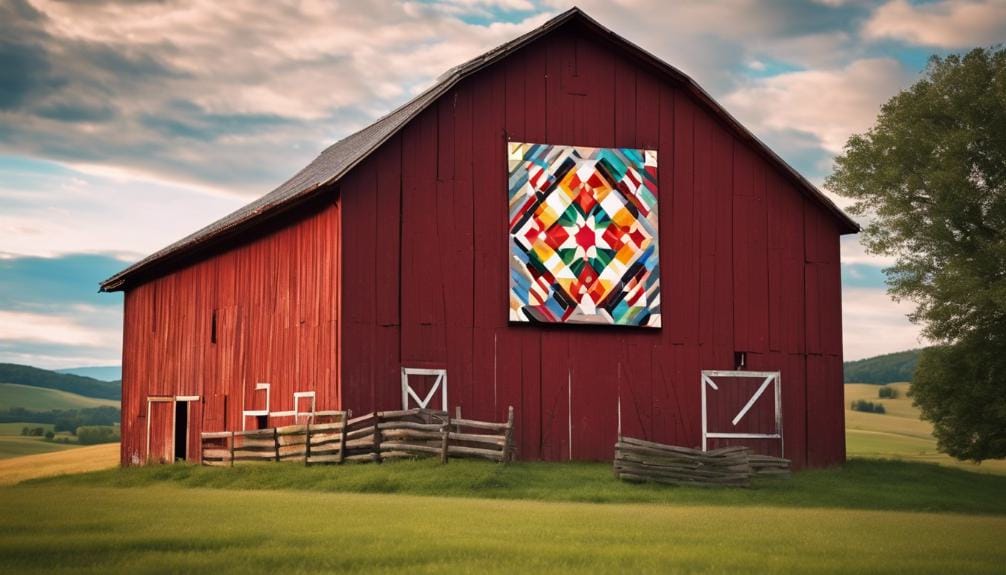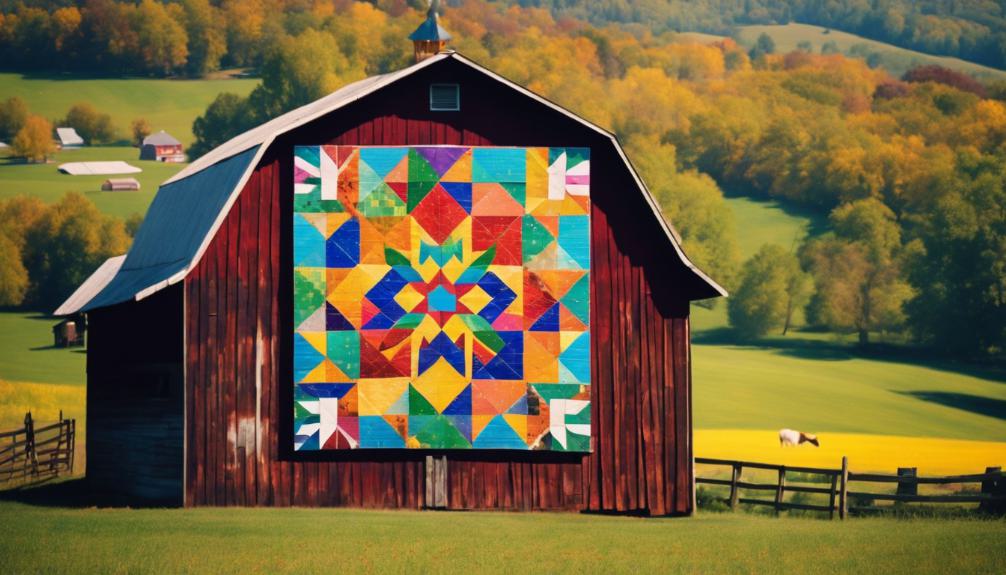What Do Barn Quilts Mean? Exploring Their Symbolism and History
Did you know that there are over 8,000 barn quilts scattered across rural landscapes in the United States alone?
These colorful geometric patterns hold more than just visual appeal; they represent a rich tapestry of history, culture, and community identity.
As you explore the world of barn quilts, you’ll uncover a hidden language of symbols, stories, and traditions waiting to be deciphered.
From their humble beginnings to their modern-day significance, barn quilts offer a window into a world of creativity and heritage worth exploring further.
Key Takeaways
- Barn quilts symbolize cultural heritage and community connection.
- They reflect local values, history, and traditional quilt patterns.
- Barn quilts foster community pride, unity, and economic growth.
- Designs convey unique stories, celebrate heritage, and showcase artistic expressions.
Origins of Barn Quilts
The origins of barn quilts can be traced back to European immigrants who arrived in America around 300 years ago. These settlers brought with them a rich tradition of quilting, a practice that wasn’t only functional but also held cultural significance. Initially, barn quilts served as a form of identification and decoration on barns, adding a touch of warmth and artistry to the wooden structures.
Over time, the designs of barn quilts evolved from traditional quilt patterns to large geometric shapes. This transition wasn’t merely for aesthetic purposes but also for practical reasons. The bold geometric patterns painted on wood were more visible from a distance, allowing them to serve as landmarks or signals for travelers. This change in design also made them easier to spot from above, especially during times of war when they were used to communicate vital information.
The trend of barn quilts spread from Pennsylvania to other colonies and states, becoming a common sight across rural America. During conflicts like the Revolutionary and Civil Wars, barn quilts played a crucial role in signaling safety and supplies. Their presence on barns served as a beacon of hope and assistance for those in need.
Symbolism Behind Barn Quilts

Symbolizing various aspects of history and personal identity, barn quilts hold a deeper significance beyond their decorative appearance on rural structures. The patterns, colors, and designs of barn quilts often carry rich symbolism, reflecting a multitude of meanings for those who understand their significance.
- Historical Significance: Barn quilts can symbolize important historical events or movements. For instance, during wars, barn quilts were used as markers for safety and supplies, providing a link to the past and honoring the sacrifices made by previous generations.
- Cultural Heritage: These quilts serve as representations of heritage, values, and beliefs. The unique designs on barn quilts can reflect a family’s history, traditions, or even their spiritual or cultural connections, showcasing a sense of belonging and identity.
- Community Connection: Each barn quilt tells a story that goes beyond the individual family. They can represent the community’s shared history, the bond between neighbors, or the collective experiences of the people living in the area. By displaying these quilts, communities create a visible link to their shared past and present, fostering a sense of unity and pride.
Understanding the symbolism behind barn quilts adds a layer of depth to their beauty, connecting individuals not only to their personal history but also to a broader narrative of community and tradition.
Cultural Significance of Barn Quilts

Reflecting the rich tapestry of local heritage and traditional quilt patterns, barn quilts hold a significant cultural resonance in rural communities. These intricate displays of quilt patterns on barns serve as artistic expressions of rural life, celebrating the history and values of the communities they adorn. Each quilt square, with its vibrant colors and geometric shapes, tells a unique story about the area’s local history, culture, or agricultural traditions. By showcasing these traditional quilt patterns, barn quilts act as public galleries that highlight America’s cultural tapestry, paying homage to the simplicity and hard work that are fundamental to rural life.
Barn quilts aren’t just decorative; they’re symbols of community engagement and pride. As pieces of Americana folk art, they evoke a sense of nostalgia and connection to the nation’s past. The presence of barn quilts inspires individuals to engage with their heritage and fosters a sense of belonging within the community. Through these displays, people come together to appreciate the beauty of traditional quilt patterns and the stories they represent. Overall, barn quilts play a vital role in preserving local heritage, promoting community engagement, and celebrating the cultural significance of rural America.
Interpretation of Barn Quilt Designs

Moving from the cultural significance of barn quilts, exploring the interpretation of barn quilt designs reveals a deeper connection to heritage, history, and community pride embedded within these artistic expressions. The intricate patterns and colors of barn quilts hold significant meaning beyond mere decoration, reflecting the rich tapestry of stories and values within a community.
- Heritage and History: Barn quilt designs often draw inspiration from traditional quilt patterns that have been passed down through generations. By incorporating these patterns into the designs, barn quilts become a visual representation of the community’s heritage and history, preserving the customs and stories of the past.
- Community Pride: The creation and display of barn quilts serve as a source of pride for the community. These vibrant artworks not only beautify the rural landscapes but also showcase the unity and creativity of the people who contribute to their making. Each barn quilt design becomes a symbol of collective pride and identity for the community.
- Local Landscapes and Agriculture: Some barn quilt designs feature elements of farm life, agriculture, or local landscapes, paying homage to the land and livelihood that sustain the community. These motifs celebrate the connection between the people and the environment, highlighting the importance of agriculture in shaping the community’s identity.
Impact of Barn Quilts in Communities

The influence of barn quilts on communities encompasses a multitude of positive outcomes, from fostering cultural pride to boosting local economies through tourism. Barn quilts play a vital role in enhancing community spirit and unity, as residents come together to create and display these unique pieces of art. This collaborative effort not only beautifies the local landscape but also strengthens the bonds among community members.
| Positive Outcomes of Barn Quilts in Communities |
|---|
| Foster Cultural Pride and Identity |
| Boost Local Economies through Tourism |
| Preserve Heritage and History |
Moreover, barn quilts contribute significantly to local economies by attracting tourists interested in folk art and rural exploration. The influx of visitors seeking out these intricate designs drives tourism revenue, supporting small businesses and highlighting the creativity present within the community. Additionally, these quilts serve as visual storytellers, preserving regional heritage and history through their diverse patterns and motifs. By showcasing the area’s past, barn quilts create a sense of cultural identity and pride within communities, connecting residents to their roots and traditions. Community events and festivals frequently center around barn quilts, further emphasizing their artistic and historical significance and bringing people together in celebration.
Frequently Asked Questions
Do Barn Quilt Designs Have Meanings?
Barn quilt designs do have meanings. Reflecting heritage and personal stories, these patterns hold significance. They convey messages unique to creators through colors, shapes, and motifs. Some are symbolic, representing unity, tradition, or beliefs.
What Is the Story Behind Barn Quilts?
The story behind barn quilts traces back to Ohio in 2001, where they were born as a tribute. Since then, these quilt patterns have proliferated, becoming a cultural phenomenon that celebrates heritage, attracts tourists, and boosts local economies.
Why Do People Hang Barn Quilts?
You hang barn quilts to celebrate heritage, add aesthetic value, and foster community pride. They symbolize personal stories and attract tourists, contributing to local economies. Displaying these quilts showcases art, craftsmanship, and cultural traditions.
What Do the Quilt Stars on Barns Mean?
Quilt stars on barns symbolize unity, heritage, and community pride. They serve as landmarks, decorative pieces, and storytelling elements on rural buildings, conveying historical significance, cultural identity, and personal connections. Their meanings reflect local traditions and values.
Conclusion
In conclusion, barn quilts hold deep historical roots and cultural significance, serving as visual representations of community pride and heritage. These painted patterns not only beautify buildings but also tell stories and preserve traditions.
By celebrating rural artistry and promoting tourism, barn quilts have become symbols of unity and creativity in communities across the country. Their impact on local culture and appreciation for folk art is undeniable, making them a cherished part of our national heritage.
